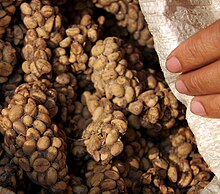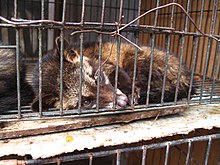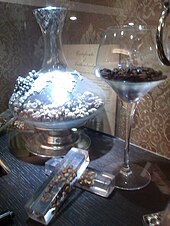
Coprophagia or coprophagy is the consumption of feces. The word is derived from the Ancient Greek κόπρος kópros "feces" and φαγεῖν phageîn "to eat". Coprophagy refers to many kinds of feces-eating, including eating feces of other species (heterospecifics), of other individuals (allocoprophagy), or one's own (autocoprophagy) – those once deposited or taken directly from the anus.

The Asian palm civet, also called common palm civet, toddy cat and musang, is a viverrid native to South and Southeast Asia. Since 2008, it is IUCN Red Listed as Least Concern as it accommodates to a broad range of habitats. It is widely distributed with large populations that in 2008 were thought unlikely to be declining. In Indonesia, it is threatened by poaching and illegal wildlife trade; buyers use it for the increasing production of kopi luwak.

Coffee is a beverage brewed from roasted coffee beans. Darkly colored, bitter, and slightly acidic, coffee has a stimulating effect on humans, primarily due to its caffeine content. It has the highest sales in the world market for hot drinks.

Coffee production is the industrial process of converting the raw fruit of the coffee plant into the finished coffee. The coffee cherry has the fruit or pulp removed leaving the seed or bean which is then dried. While all green coffee is processed, the method that is used varies and can have a significant effect on the flavor of roasted and brewed coffee. Coffee production is a major source of income for 12.5 million households, most in developing countries.
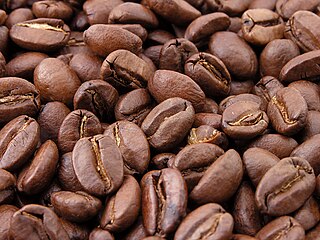
A coffee bean is a seed from the Coffea plant and the source for coffee. It is the pip inside the red or purple fruit. This fruit is often referred to as a coffee cherry, and like the cherry, it is a fruit with a pip. Even though the coffee beans are not technically beans, they are referred to as such because of their resemblance to true beans. The fruits most commonly contain two stones with their flat sides together. A small percentage of cherries contain a single seed, instead of the usual two, called a "peaberry". The peaberry occurs only between 10% and 15% of the time, and it is a fairly common belief that they have more flavour than normal coffee beans. Like Brazil nuts and white rice, coffee beans consist mostly of endosperm.

A kopitiam or kopi tiam is a type of coffee shop mostly found in parts of Indonesia, Malaysia, Singapore, Brunei and Southern Thailand patronised for meals and beverages, and traditionally operated by the Chinese community of these countries. The word kopi is an Indonesian and Malay term for coffee and tiam is the Hokkien/Hakka term for shop. Traditional kopitiam menus typically feature simple offerings: a variety of foods based on egg, toast, kaya, plus coffee, tea, Horlicks and Milo. Modern kopitiams typically feature multiple food stalls that offer a wider range of foods.
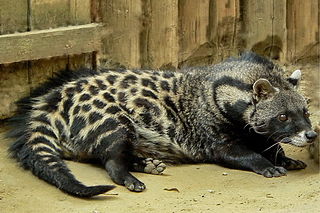
A civet is a small, lean, mostly nocturnal mammal native to tropical Asia and Africa, especially the tropical forests. The term civet applies to over a dozen different species, mostly from the family Viverridae. Most of the species's diversity is found in southeast Asia. Civets do not form a monophyletic group, as they consist only of certain members of the Viverridae, Eupleridae, and Nandiniidae.
The Herveys Range Heritage Tea Rooms are an historical cafe located at the top of the Hervey Range, approximately 32 kilometres (20 mi) north-west of Townsville in North Queensland, Australia. The tea rooms are famous for being the only cafe in Queensland to include kopi luwak coffee on their menu, hailed as the most expensive coffee in the world.

Indonesia was the fourth-largest producer of coffee in the world in 2014. Coffee cultivation in Indonesia began in the late 1600s and early 1700s, in the early Dutch colonial period, and has played an important part in the growth of the country. Indonesia is geographically and climatologically well-suited for coffee plantations, near the equator and with numerous interior mountainous regions on its main islands, creating well-suited microclimates for the growth and production of coffee.

Gesha coffee, sometimes referred to as Geisha coffee, is a variety of coffee tree that originated in the Gori Gesha forest, Ethiopia, though it is now grown in several other nations in Africa, Asia, and the Americas. It is widely known for its unique flavor profile of floral and sweet notes, its high selling price, and its exclusivity as its demand has increased over the years.
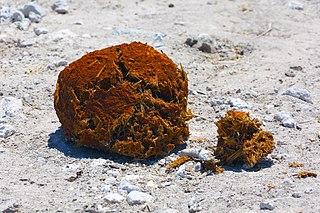
Feces are the solid or semi-solid remains of food that was not digested in the small intestine, and has been broken down by bacteria in the large intestine. Feces contain a relatively small amount of metabolic waste products such as bacterially altered bilirubin, and dead epithelial cells from the lining of the gut.

Kopi Tubruk is an Indonesian-style coffee where hot water is poured over fine coffee grounds directly in the glass, without any filtration, usually with added sugar.

Trung Nguyên is a Vietnamese business group involved in the production, processing and distribution of coffee. The firm was founded in 1996 in Buôn Ma Thuột, Đắk Lắk Province by Dang Le Nguyen Vu and Le Hoang Diep Thao upon realizing the potential and opportunities for the development of the coffee industry in opening Vietnam’s economy. Trung Nguyên is the largest domestic coffee brand within Vietnam, and exports its products to more than 60 countries, including major markets such as the United States, the European Union, the United Kingdom, Germany, China, Canada, Russia, Japan, Dubai, Australia, and ASEAN countries, including its international hub in Singapore. The group is composed of several subsidiaries, among them Trung Nguyên Corporation JSC, Trung Nguyên Instant Coffee Company JSC, Trung Nguyên Coffee LLC, G7 Commercial Services Company, Đặng Lê Tourism Company JSC and Trung Nguyên Franchising Company JSC. Its most successful product is G7 instant coffee, which took top domestic position in 2016 and has recorded 200% growth in its export markets. Following a high-profile separation with her husband, in 2016 Le Hoang Diep Thao established an independent spin-off firm in Singapore, Trung Nguyên International, which she used as a springboard for her own coffee chain TNI King Coffee. King Coffee now exports its products to more than 120 countries worldwide.
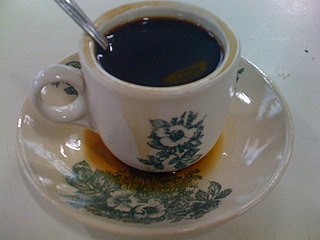
Kopi, also known as Nanyang coffee, is a traditional coffee beverage found in several Maritime Southeast Asian nations. Often brewed to be highly caffeinated in strength, it is commonly served with sugar and/or milk-based condiments. This drink originated from the British Malaya era, with Hainanese cultural roots. The name of the drink is derived from the Malay term for coffee. The term Nanyang, which means "South Sea" in Mandarin, refers to Maritime Southeast Asia. Kopi culture vocabulary is grounded in Hokkien dialect as a result of historical immigration to Maritime Southeast Asia from the Minnan region in the south-eastern part of Fujian Province in Southeastern Mainland China. The beverage is usually served in coffee shops, Hawker centres and kopitiams across the region.

Black Ivory Coffee is a brand of coffee produced by the Black Ivory Coffee Company Ltd in northern Thailand from Arabica coffee beans consumed by elephants and collected from their waste. The taste of Black Ivory coffee is influenced by elephants' digestive enzymes, which breaks down the coffee's protein. The company claims to rescue elephants from tourist trade abuse.

Ginseng coffee is a beverage prepared from coffee and ginseng root.

Balinese cuisine is a cuisine tradition of Balinese people from the volcanic island of Bali. Using a variety of spices, blended with the fresh vegetables, meat and fish. Part of Indonesian cuisine, it demonstrates indigenous traditions, as well as influences from other Indonesian regional cuisine, Chinese and Indian. The island's inhabitants are predominantly Hindu and culinary traditions are somewhat distinct with the rest of Indonesia, with festivals and religious celebrations including many special foods prepared as the offerings for the deities, as well as other dishes consumed communally during the celebrations.
